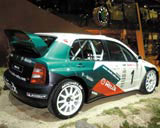The last laugh
Once the subject of ridicule, car brand Skoda is currently enjoying a reversal of fortune under chief designer Thomas Ingenlath. Nargess Shahmanesh reports

Thomas Ingenlath’s CV
1964 Born – Krefeld, Germany
1989 Studies automobile design at University in Pforzheim
1991 Masters in vehicle design at the Royal College of Art
1991 Exterior designer at Audi Design
1995 Chief exterior designer for passenger cars at Volkswagen Design
March 2000 Appointed chief designer at Skoda Auto
What do you call a Skoda with a sun-roof? A skip. Skoda jokes, never particularly funny at the best of times, had their minor heyday in the late 1980s. But they petered out along with Skoda’s century-long history when Volkswagen took over the brand in 1991.
Skoda’s heritage stretches back over 100 years to 1895 when it started manufacturing bicycles. It made its first car, the Voiurette, a decade later in 1905 and things took off. But by the 1970s the image of Skoda was associated with poor eastern European design and quality and the jokes were born. Now, with the launch last month of the Fabia RS passenger car and its sister rally car, a Skoda joke would be about as appropriate, and welcome, as one about Muslims or bombing.
Thomas Ingenlath, Skoda’s chief designer, was involved in the design of the Fabia RS and the Fabia World Rally Car. Motor racing is good for the brand, it keeps the spirit going, he says. ‘Motorsport is part of the company’s history; not something we just gave our name to. The Fabia RS is a nice beefy little car and a lot of fun to drive. The fabrics used inside are obviously artificial textiles, but in the way that, say, Nike designs sportswear. It’s a younger way to interpret the sports car,’ he says.
To become a Skoda designer, apart from having the professional skills, people must possess something extra, says Ingenlath, who joined Skoda from Volkswagen Design three years ago. ‘Skoda cars don’t have to be 100 per cent mainstream. So if a student came up with an idea that might be too crazy for someone else, it may interest us. We like unusual people and we can offer them the ability to develop their craziness,’ he adds.
Skoda employs 25 international designers at its design centre at Mladá Boleslav, near Prague. ‘We work in the Czech Republic and we are interested in the culture. We have many Czech people here, but we make cars for an international market and so we need to have an international outlook,’ he says.
Ingenlath himself has always wanted to be a car designer, although at first he wasn’t sure if it was just a childish dream. He started off his career as an industrial designer, but two years into the job he realised he was more suited to car design. This is when he began work at Volkswagen, followed by a trainee place at Audi, who sponsored him to go to the Royal College of Art.
‘The first day I came to London I knew it was the right decision. The college delivers space for people from all over the world to come together and that creates a truly international creative atmosphere.’
Ingenlath believes the company’s history is vital to understand the brand. ‘[VW’s acquisition] was a necessary step in establishing Skoda as a company that makes quality cars,’ says Ingenlath, ‘and it has taken ten years to get to where it is now.’ Ingenlath’s main challenge is how far he can modernise a brand with so much history. ‘You have to fight with yourself to see how much tradition you must keep, and at the same time how far you can push forward the brand so there is no stagnation.’
Ingenlath believes in maintaining the brand heritage. Although it’s a Czech company, it is first and foremost Skoda and that is its tradition, he says. ‘The customer there may not know the depths of Czech culture, but he can feel that this is a car from Europe and perhaps this is why he buys a car,’ he says. It’s no coincidence, perhaps, that Skoda sells well outside Europe, particularly in India.
The design essence of Skoda is its front grill, he says. ‘You recognise Skoda when you look into its face.’ The grill belongs to the long tradition of the brand. It is a feature, in Ingenlath’s view, that only a company with a hundred years of car-making history can get away with and turn into a design feature: indeed, it is considering developing it into an icon itself.
Working at Volkswagen teaches you to value quality, but Skoda makes cars that are value for money, he claims. ‘Quality for us is not necessarily dependent on money, but is in the quality of detail you give to the design and making.’
The Volkswagen group houses seven other brands. Ingenlath says there is a degree of co-ordination between them and the company tries to harmonise the brands so they fit together like a jigsaw puzzle. ‘As a backup, being part of VW is perfect. We can share the resources for technical development,’ he admits. ‘As a designer you always have limitations.’
But being part of Volkswagen is also a challenge, he says. There is a competitive element between the different design houses. ‘You want to be the brand with the clever solutions.’
Ingenlath has himself in mind when he designs cars. ‘I like to design cars that I desire. We make a range of cars, from those oriented to a big family to those for older people, but at the end people have to want to buy it.’ Sun-roof or no sun-roof.
-
Post a comment




